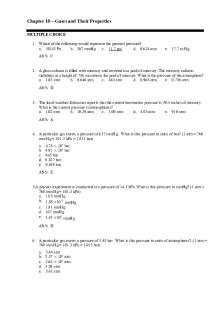Chemistry- Reversible reactions and equilibria PDF

| Title | Chemistry- Reversible reactions and equilibria |
|---|---|
| Course | Chemistry |
| Institution | University of Salford |
| Pages | 3 |
| File Size | 120.8 KB |
| File Type | |
| Total Downloads | 40 |
| Total Views | 192 |
Summary
Reversible reactions and Equilibria with questions and answers. These notes are a key asset to revision which helps revision....
Description
Reversible reactions and equilibria - Chemistry Reversible reactions In principle, all chemical reactions are reversible reactions. This means that the products can be changed back into the original reactants. This is not obvious when a reaction 'goes to completion', where very little or no reactants are left. Examples of reactions that go to completion are: -complete combustion of a fuel -many precipitation reactions -effervescence reactions in which a gas escapes It is more obvious in reactions that do not go to completion that the reaction is reversible. This is the case when the reaction mixture contains both reactants and products.
Examples of reversible reactions Ammonium chloride Ammonium chloride is a white solid. It breaks down when heated, forming ammonia and hydrogen chloride. When these two gases are cool enough, they react together to form ammonium chloride again. This reversible reaction can be modelled as: Ammonium chloride ⇌ ammonia + hydrogen chloride NH4Cl(s) ⇌ NH3(g) + HCl(g) -The symbol ⇌ has two half arrowheads, one pointing in each direction. It is used in equations that model reversible reactions: -the forward reaction is the one that goes to the right -the backward reaction is the one that goes to the left
Copper sulfate Blue copper sulfate is described as hydrated. The copper ions in its crystal lattice structure are surrounded by water molecules. This water is driven off when blue hydrated copper sulfate is heated, leaving white anhydrous copper sulfate. This reaction is reversible:
Hydrated copper sulfate ⇌ anhydrous copper sulfate + water CuSO4.5H2O(s) ⇌ CuSO4(s) + 5H2O(l)
The Haber process Making ammonia Ammonia is an important industrial product used to make fertilisers, explosives and dyes. It is manufactured using the Haber process. This involves a reversible reaction between nitrogen and hydrogen:
N2(g) + 3H2(g) ⇌ 2NH3(g)
The reaction can reach a dynamic equilibrium.
In the Haber process: -nitrogen (extracted from the air) and hydrogen (obtained from natural gas) are pumped through pipes -a compressor increases the gas pressure to 200 atmospheres -the pressurised gases are heated to 450°C and passed through a reaction chamber containing an iron catalyst to speed up the reaction -the reaction mixture is cooled so that ammonia liquefies and can be removed -unreacted nitrogen and hydrogen are recycled The conditions are chosen to ensure the process of making ammonia is as profitable as possible. The equilibrium position of a reversible reaction is a measure of the concentrations of the reactants and products at equilibrium. Using the Haber process as an example: N2(g) + 3H2(g) ⇌ 2NH3(g) The equilibrium position is: to the left if the concentrations of N2 and H2 are greater than the concentration of NH3 to the right if the concentration of NH3 is greater than the concentrations of N2 and H2
The equilibrium position can be changed by altering the reaction conditions, such as by: changing the pressure changing the concentration changing the temperature Changing the pressure In a reaction involving gases, if the pressure is increased, the equilibrium position moves in the direction of the fewest molecules of gas. There are fewer molecules on the right hand side of the equation for the Haber process: If the pressure is increased, the equilibrium position moves to the right.
Question Q1. Calcium carbonate decomposes when it is heated: CaCO3(s) ⇌ CaO(s) + CO2(g) Predict the effect of increasing the pressure. = The equilibrium position will move to the left, in the direction of the fewest molecules of gas.
Q2. Iron(III) ions react with thiocyanate ions, SCN-, in a reversible reaction: Fe3+(aq) + SCN-(aq) ⇌ FeSCN2+(aq) Predict the effect of adding more iron(III) ions. = The equilibrium position will move to the right, in the direction away from Fe3+ in the equation.
Q3. Hydrogen can be manufactured by reacting carbon with steam: C(s) + H2O(g) ⇌ H2(g) + CO(g) (forward reaction is endothermic) Predict the effect of increasing the temperature, at constant pressure. = The equilibrium position will move to the right, in the direction of the endothermic reaction....
Similar Free PDFs

Reversible Reactions Report
- 5 Pages

Organic Chemistry I Reactions
- 10 Pages

4. Solution Equilibria
- 8 Pages

Proceso reversible
- 7 Pages

Acids, bases, equilibria & esters
- 44 Pages

Acute Kidney Injury Reversible
- 17 Pages
Popular Institutions
- Tinajero National High School - Annex
- Politeknik Caltex Riau
- Yokohama City University
- SGT University
- University of Al-Qadisiyah
- Divine Word College of Vigan
- Techniek College Rotterdam
- Universidade de Santiago
- Universiti Teknologi MARA Cawangan Johor Kampus Pasir Gudang
- Poltekkes Kemenkes Yogyakarta
- Baguio City National High School
- Colegio san marcos
- preparatoria uno
- Centro de Bachillerato Tecnológico Industrial y de Servicios No. 107
- Dalian Maritime University
- Quang Trung Secondary School
- Colegio Tecnológico en Informática
- Corporación Regional de Educación Superior
- Grupo CEDVA
- Dar Al Uloom University
- Centro de Estudios Preuniversitarios de la Universidad Nacional de Ingeniería
- 上智大学
- Aakash International School, Nuna Majara
- San Felipe Neri Catholic School
- Kang Chiao International School - New Taipei City
- Misamis Occidental National High School
- Institución Educativa Escuela Normal Juan Ladrilleros
- Kolehiyo ng Pantukan
- Batanes State College
- Instituto Continental
- Sekolah Menengah Kejuruan Kesehatan Kaltara (Tarakan)
- Colegio de La Inmaculada Concepcion - Cebu









